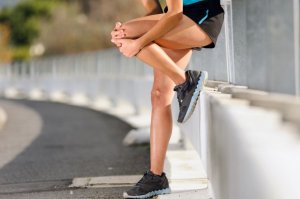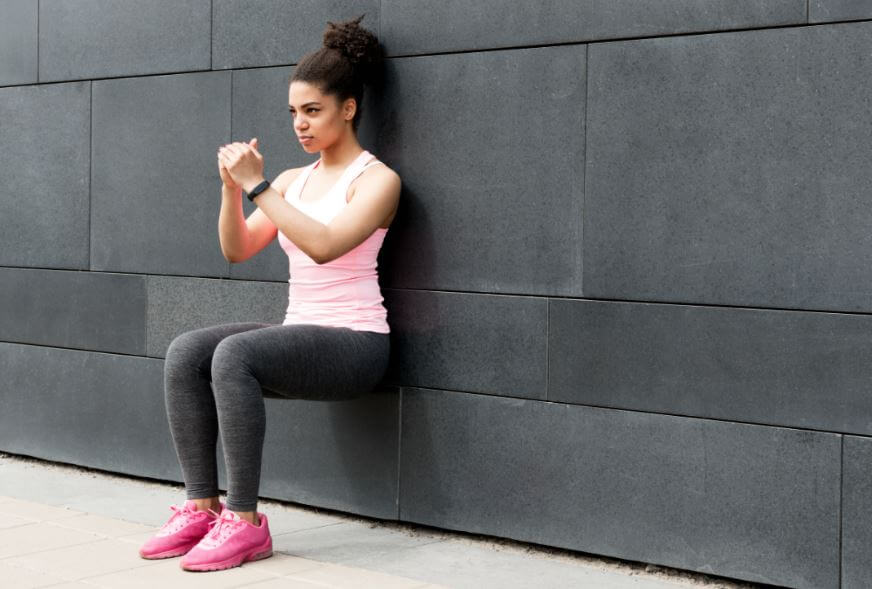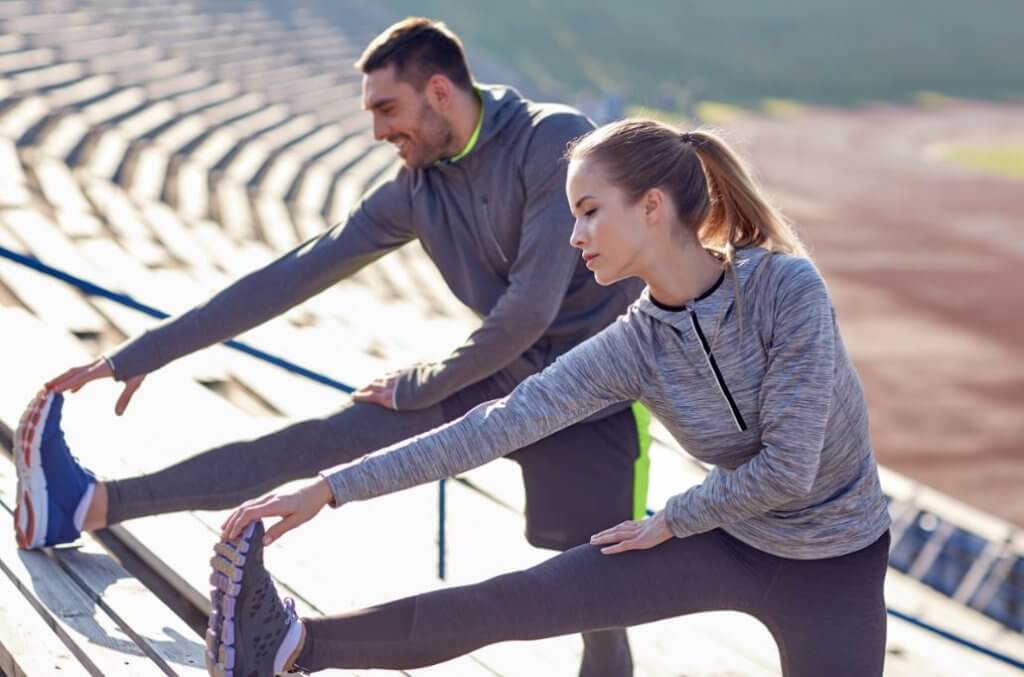Four Exercises to Reduce Knee Pain

Those who suffer from knee pain should know that the best way to help alleviate some discomfort is to perform certain exercises or stretches. Therefore, in the following article, we will give you a list of the four best exercises to help reduce knee pain.
Certainly, one of the best things you can do to reduce knee pain is simply maintaining an active and healthy lifestyle. Although, you should bear in mind that, in these cases, it is best to do low impact activities, such as riding a bicycle, brisk walking or swimming.
In addition, you should know that multiple muscles overlap the knee joint, as they work together to flex, extend and stabilize the knee. As a consequence, the exact reason for the pain is not always obvious. However, below we have prepared a list of some exercises to help reduce and relieve knee pain. Keep reading and we will tell you everything you need to know!
The four best exercises to reduce knee pain
1. Exercise with ball
To begin, we will tell you about an exercise to reduce knee pain that you can perform with a tennis ball or a lacrosse ball. It is a movement that allows you to understand how much tension there is, both in the calf and the hamstring. To do the exercise, you must sit on the floor. Then, bring your right foot to your glute, so that the knee is bent.
Next, wedge a lacrosse or tennis ball under the right knee, placed between the calf and the hamstring. The goal is to create compressive force by pulling the shin towards you. Then, rotate your foot in alternating circular movements to help create space in the knee joint. We recommend that you continue until you feel that the tension in these areas is relieved.
Read more: Seven Best Exercises Using a Medicine Ball
2. Wall squats
Next, wall squats are another effective movement to help reduce pain in the knees. They strengthen the quadriceps, buttocks and many of the other small muscle groups that surround the knee joints, which in turn helps to keep them healthy.

The exercise is very simple: stand with your back against the wall, with your feet at the same width as your hips. Then, slide your back down the wall to squat, as if you were sitting on a chair. Keep in mind that the lower you squat, the more challenging the movement will be. As a result, you will feel more pressure in your knees. It is best to hold the position for about 30 seconds, or until your muscles are completely exhausted.
“One does not make himself greater by measuring the smallness of his pain.”
-Ernst Wiecherte-
3. Straight Leg Lifts
Thirdly, we present the straight leg lifts. You must start by lying on your back on the floor facing up, keeping one leg bent and the other straight.
Next, lift the straightened leg a few inches off the ground, while tensing your thigh muscles. Do not forget to hold this pose for about 5 seconds, before slowly lowering your leg. Then, repeat this on the other side. As much as possible, try to avoid sudden movements, and do not arch your back.
Learn more: Strong Legs and Glutes: Effective Exercises
4. Calf Stretch
Finally, here’s another great exercise to help reduce knee pain. It consists of stretching the calf muscles since this is necessary to alleviate any pain that you might have in your knees. This area is sometimes neglected.

Use a wall to support you. Then, flex the right foot and place the heel in the spot where the floor meets the wall. Remember, your toes should be raised, while the heel should remain on the floor. Also, the leg should remain as straight as possible. Then, lean toward your front leg, keeping the stretch at its deepest point. Hold for 5 seconds before releasing. Then, repeat the same stretch with your left leg until you perform between 10 and 15 repetitions on each leg.
Finally, remember that exercises to reduce knee pain are ideal for any athlete who feels discomfort when doing any type of sporting activity. We are convinced that if you try the exercises for a few weeks, you will soon begin to see the results!
Those who suffer from knee pain should know that the best way to help alleviate some discomfort is to perform certain exercises or stretches. Therefore, in the following article, we will give you a list of the four best exercises to help reduce knee pain.
Certainly, one of the best things you can do to reduce knee pain is simply maintaining an active and healthy lifestyle. Although, you should bear in mind that, in these cases, it is best to do low impact activities, such as riding a bicycle, brisk walking or swimming.
In addition, you should know that multiple muscles overlap the knee joint, as they work together to flex, extend and stabilize the knee. As a consequence, the exact reason for the pain is not always obvious. However, below we have prepared a list of some exercises to help reduce and relieve knee pain. Keep reading and we will tell you everything you need to know!
The four best exercises to reduce knee pain
1. Exercise with ball
To begin, we will tell you about an exercise to reduce knee pain that you can perform with a tennis ball or a lacrosse ball. It is a movement that allows you to understand how much tension there is, both in the calf and the hamstring. To do the exercise, you must sit on the floor. Then, bring your right foot to your glute, so that the knee is bent.
Next, wedge a lacrosse or tennis ball under the right knee, placed between the calf and the hamstring. The goal is to create compressive force by pulling the shin towards you. Then, rotate your foot in alternating circular movements to help create space in the knee joint. We recommend that you continue until you feel that the tension in these areas is relieved.
Read more: Seven Best Exercises Using a Medicine Ball
2. Wall squats
Next, wall squats are another effective movement to help reduce pain in the knees. They strengthen the quadriceps, buttocks and many of the other small muscle groups that surround the knee joints, which in turn helps to keep them healthy.

The exercise is very simple: stand with your back against the wall, with your feet at the same width as your hips. Then, slide your back down the wall to squat, as if you were sitting on a chair. Keep in mind that the lower you squat, the more challenging the movement will be. As a result, you will feel more pressure in your knees. It is best to hold the position for about 30 seconds, or until your muscles are completely exhausted.
“One does not make himself greater by measuring the smallness of his pain.”
-Ernst Wiecherte-
3. Straight Leg Lifts
Thirdly, we present the straight leg lifts. You must start by lying on your back on the floor facing up, keeping one leg bent and the other straight.
Next, lift the straightened leg a few inches off the ground, while tensing your thigh muscles. Do not forget to hold this pose for about 5 seconds, before slowly lowering your leg. Then, repeat this on the other side. As much as possible, try to avoid sudden movements, and do not arch your back.
Learn more: Strong Legs and Glutes: Effective Exercises
4. Calf Stretch
Finally, here’s another great exercise to help reduce knee pain. It consists of stretching the calf muscles since this is necessary to alleviate any pain that you might have in your knees. This area is sometimes neglected.

Use a wall to support you. Then, flex the right foot and place the heel in the spot where the floor meets the wall. Remember, your toes should be raised, while the heel should remain on the floor. Also, the leg should remain as straight as possible. Then, lean toward your front leg, keeping the stretch at its deepest point. Hold for 5 seconds before releasing. Then, repeat the same stretch with your left leg until you perform between 10 and 15 repetitions on each leg.
Finally, remember that exercises to reduce knee pain are ideal for any athlete who feels discomfort when doing any type of sporting activity. We are convinced that if you try the exercises for a few weeks, you will soon begin to see the results!
All cited sources were thoroughly reviewed by our team to ensure their quality, reliability, currency, and validity. The bibliography of this article was considered reliable and of academic or scientific accuracy.
- Klapper R, Huey L. (2006). Salud para tus rodillas. Ediciones Robinbook. Disponible en: https://books.google.es/books?hl=es&lr=&id=1poBE8cCOR8C&oi=fnd&pg=PA9&dq=related:mf91wUsGgP4J:scholar.google.com/&ots=aSLkOlIYiS&sig=dbUhxL0UqlZHLnEEiTpSCcfj2jE#v=onepage&q&f=false
- Neiger H, Gosselin P, Lacomba M. (2007). Estiramientos analíticos manuales, técnicas pasivas”. Editorial Médica Panamericana. Disponible en: https://books.google.es/books?hl=es&lr=&id=XsDNpUrcJ7IC&oi=fnd&pg=PA5&dq=Henri+Neiger.+%E2%80%9CEstiramientos+anal%C3%ADticos+manuales,+t%C3%A9cnicas+pasivas%E2%80%9D.+Ed+Panamericana.+(1998)&ots=9M7g5PqGqP&sig=4YvLL-zcTYF25pXk8jG5m9Sgxoo#v=onepage&q&f=false
- Pinzón I. (2018). Dolor y Ejercicio. Archivos de medicina 18(1), pp 181-200. Disponible en: https://revistasum.umanizales.edu.co/ojs/index.php/archivosmedicina/article/view/2035/3139
This text is provided for informational purposes only and does not replace consultation with a professional. If in doubt, consult your specialist.








